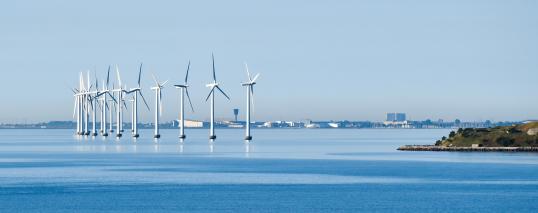Climate change and global warming pose existential threats to society. If we want to deliver a greener and cleaner planet to future generations, immediate action is required to revolutionise our economy and curb CO2 emissions. Over the next few years, our entire world will be fighting what is seemingly an insurmountable challenge: to halt – and hopefully to reverse – the current rising temperature trend.
With this ambitious goal in mind, the European Union adopted its Green Deal – a set of policy initiatives that strives to make Europe the first climate-neutral continent by 2050. Decarbonising our energy system is crucial for meeting both the 2050 goal and the intermediate target of reducing greenhouse gas emissions by at least 55% by 2030.
Decarbonising our energy system calls for reducing our dependency on fossil fuels, increasing our energy efficiency and developing a power sector based largely on renewable resources. That is where the ocean comes into play. This immense body of salt water that covers approximately 70.8% of the Earth’s surface harbours largely untapped sources of clean energy that can be exploited by a number of different technologies.
Offshore wind energy comes from the deployment of wind farms sited in bodies of water. These offshore sites harness wind power in exactly the same way as onshore wind farms, the only difference being that the turbines are installed on the seabed or mounted on floating structures. Due to factors such as higher wind speeds and bigger turbine size, they are also capable of generating more electricity at a steadier rate than onshore turbines. Europe is the leader in offshore wind and is home to the world’s largest operational wind farms for both bottom-fixed and floating-foundation technologies. Europe’s offshore capacity is sufficiently large to meet the electricity demand in Europe – a demand which will only continue to grow in the coming years. Even though a record of 3.6 GW of offshore wind capacity was installed in Europe in 2019, the sector still requires a major investment in infrastructure and an increase in installation rates. European countries have paved the way for delivering 111 GW of wind capacity by 2030 in their National Energy and Climate Plans but reaching this will require an annual installation of almost triple the 3.6 GW of offshore capacity that was installed in 20191.
Offshore wind is not the only source of offshore renewable energy. Tidal energy generates power by exploiting the natural and incessant rise and fall of ocean tides and currents through a variety of tidal energy devices, such as spinning underwater turbines. These are similar to wind turbines in that they have blades that turn a rotor to power a generator. Wave energy, on the other hand, captures kinetic energy from waves. These wave energy generators may be installed on the surface of the water or, alternatively, some are installed hundreds of feet below the ocean’s surface.
While less popular than the other forms of ocean energy, Ocean Thermal Energy Conversion (OTEC) uses the difference between the cool temperature of deep seawaters and warmer temperatures of shallow seawaters to run a heat engine and produce electricity.
Over the years, the European Maritime and Fisheries Fund (EMFF) has funded several projects related to ocean renewable energy. For example, NeSSIE developed demonstration projects for offshore renewables in the North Sea by tapping into the existing knowledge of anti-corrosion technology and novel materials solutions in the maritime sector supply chain. Sea Wave and WESE, as well as SafeWAVE are addressing the environmental impact of ocean energy devices by delivering a comprehensive environmental impact data review. LEAPwind developed a commercial-scale process for manufacturing leading-edge wind-blade components to the offshore wind energy market. DOCC-OFF is developing a digital solution to reduce maintenance costs and increase the performance of the hydraulic pitch system – a critical component in wind turbines.
1https://windeurope.org/policy/topics/offshore-wind-energy/
More info on renewable energy
Complete list of EMFF-funded projects
| Project name | Start date | End date | Total budget in € | EU contribution in € |
| North Sea Solutions for Innovation in Corrosion for Energy (NeSSIE) | 01/05/2017 | 30/04/2019 | 845,855 | 676,684 |
| Enabling Technologies and Roadmaps for Offshore Platform Innovation (ENTROPI) | 01/04/2017 | 31/03/2019 | 743,890 | 595,114 |
| Strategic Environmental Assessment of Wave energy technologies (Sea WAVE) | 01/11/2018 | 31/12/2021 | 956,763 | 764,646 |
| Wave Energy in Southern Europe (WESE) | 01/11/2018 | 31/10/2021 | 929,606 | 743,687 |
| Leading Edge Advanced Protection using novel thermoplastic materials and processes for offshore Wind turbine blades (LEAPWind) | 01/01/2019 | 31/12/2020 | 1,502,103 | 988,067 |
| VPS for Tidal Turbine Generators (VPSTTG) | 01/01/2019 | 31/12/2020 | 1,527,594 | 992,937 |
| Offshore Robotic Wind Turbine Blade Care System (Aerones) | 01/10/2020 | 30/09/2023 | 2,494,459 | 1,746,121 |
| Auxiliary Towable Operation and Maintenance System for Offshore Wind Towers (ATOMS) | 01/09/2020 | 31/08/2022 | 3,545,109 | 2,481,576 |
| Digitalization Of Critical Components in OFFshore wind turbines (DOCC-OFF) | 01/11/2019 | 31/10/2021 | 1,001,736 | 651,127 |
| Floating Solar Energy mooRing: Innovative mooring solutions for floating solar energy (FreSher) | 01/11/2019 | 30/04/2022 | 1,091,402 | 709,409 |
| Streamlining the Assessment of environmental efFEcts of WAVE energy (SafeWave) | 01/10/2020 | 30/09/2023 | 1,893,370 | 1,514,696 |
| Engineering and upscaling of new floating renewable wind energy platform (SATHScale) | 01/11/2020 | 31/10/2023 | 3,456,062 | 2,418,896 |
| Sustainable Innovation in la Martinique: BIOfouling Solution for clean Energy (SIMBIOSE) | 01/11/2019 | 31/10/2022 | 1,300,927 | 845,603 |
| WaveRoller Wave Farm Scale-Up – Preparing to deploy the world’s first commercial wave energy farm (WaveFarm) | 01/11/2020 | 31/10/2023 | 3,556,064 | 2,489,244 |
Useful links
Green and blue energy in the spotlight at EUSEW2021

